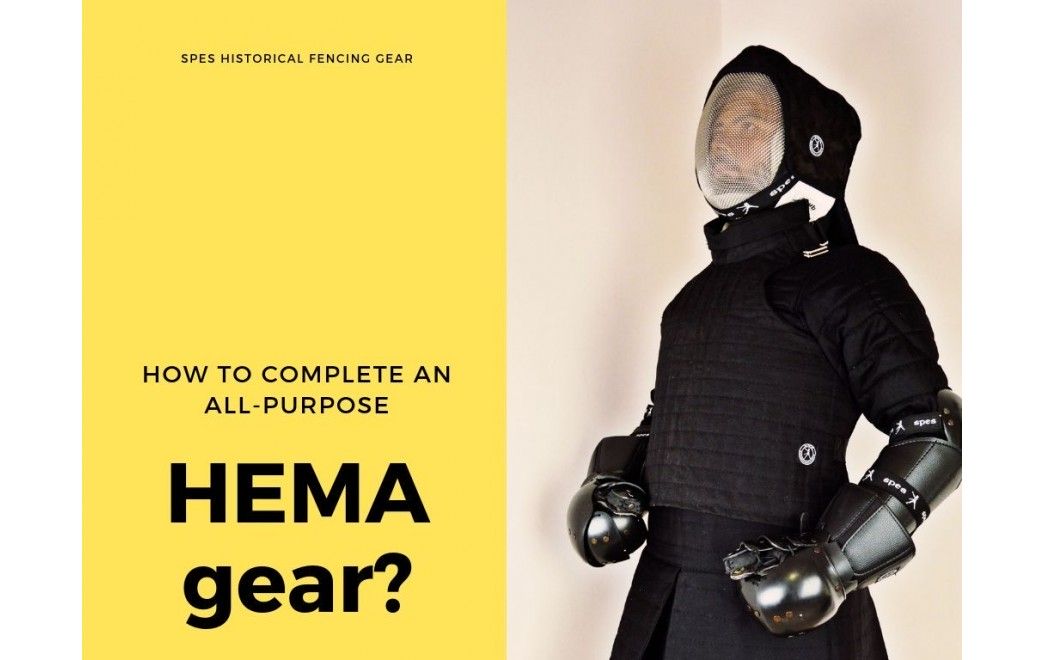How to complete an all-purpose HEMA gear? Concrete examples!
How to complete an all-purpose HEMA gear? Concrete examples!
In our last post we’ve undertook a safety topic, where Andrzej tried to solve a famous Newton’s mystery. Today, partially as a continuation of these deliberations, I would like to share my thoughts on assembling a proper HEMA gear.
In historical fencing we can list a number of weapons of different character. That is why in our shop we still didn’t introduce ready sets of HEMA equipment, so everyone could complete the best kit for their needs, own preferences, and tournament’s requirements. Still, today I will try to present possibly the most all-purpose set of HEMA clothing.
This combination will be dedicated to practitioners who still haven’t chosen their favorite weapon, or who want to practice different disciplines with one kit.
Assembling a general-purpose HEMA set, which after changing some of its elements will match any discipline, is quite a challenge. Finding proper HEMA clothing for one weapon seems to be much easier, as one weapon has specific requirements. Maybe in future publications I will try to analyze HEMA protection according to popular weapons: longsword, sword and buckler, sabre, and rapier.
I hope these tips will be helpful not only for beginners in the world of HEMA, but also skilled practitioners will find something for themselves. Because of growing requirements of tournaments, and safety reasons in general, we suggest getting HEMA jackets and pants of 800N puncture resistance. However, for the start, a 350N set will surely meet your expectations.
Main goals of a general-purpose HEMA equipment set
Let’s try to get possibly the most universal set of HEMA protectors. In choosing particular elements, take in consideration the following features:
- universality
- modularity
- level of protection (enough for heavy weapon)
- matching requirements of HEMA tournaments
Head is the basis! Head protection for HEMA
Let’s start completing our set from head and neck. Thus, rest of the body won’t be usable without these. ? The most essential part in this area will be a fencing mask. In choosing this element you should pay attention to producer’s brand and puncture resistance certificate. Most of HEMA tournaments require 1600N, while only some of them accept 350N masks. So, the choice is clear – pay some more and get a good 1600N mask. If you are looking for help here, be sure to check the WisePeasants ranking.
Later, mask has to be complemented with an occiput protector. Also, you should increase the robustness in neck area and (when we want a set for heavy weapon) ensure an additional layer on top of the head and sides. Additional protectors for mask will also lengthen its lifespan.
Of course, manufacturers have all of these spheres in their minds and there’s no problem in getting a proper covers. You can complete such set from few elements, but I recommend choosing an integrated mask overlay, like “Unity PRO”. You should also supplement it with a gorget.
Torso & arm protectors for HEMA
As a basic protection for torso and arms, I suggest getting an AP Light 350N HEMA jacket. Why? Most of all, it’s one of the lightest from available jackets (1,4-1,6 kg). Still, it ensures a decent level of protection which can be modified with attached foam covers.
Shape of a jacket is very similar to AP 350N – the most popular HEMA jacket. Even as a HEMA equipment, we can call this model quite mobile and comfy. And if you want to lower its weight, all you have to do is removing foam pads from shoulders, front, and sides of a torso. If needed, you can fill the pockets with pads from other material, like plastic.
For heavier weapons, like longsword, it is essential to use additional HEMA gear:
- to increase arm protection, get a proper forearm guards, for example SPES Geko PRO – these have additional elbow covers which can be detached and used separately
- torso protection should be strengthened in more challenging HEMA fights (longsword) – to do this, we recommend a plastron. Our VG model ensures not only an additional amortization layer, but also lowers the risk of injuries caused by thrusts. Another solution is an inner plastic chest protector to put under the jacket.
HEMA gloves – how to choose a proper model?
During HEMA training, hands are probably the most exposed to injuries part of the body. It’s hard for any compromise here.
This is why I believe one should have two pairs of gloves:
- for fighting – heavy, armored, appreciated all over the world Lobster model
- for light sparrings – ligher model, ensuring basic protection, like Duelling gloves
Still, if I would HAVE TO choose 1 pair, I would choose Lobsters. Perfect level of protection, meeting the highest standards of tournament requirements.
I can mention that currently we are working on model combining high level of protection with mobility. Thus, soon we can fulfill a gap on HEMA gear market, but we’ll talk about the details some other time.
HEMA pants – mobility or protection?
What if there’s an option of conneting a high level of protection with full mobility in one pair HEMA pants? Actually, it’s possible. And HEMA equipment manufacturers seem to give a choice on this field.
Take a look at our Locust fencing pants 350N. These without foam covers (which are removable) will be perfect for lighter sparring fights. Their attitudes in this form are low weight and pratically unlimited mobility. After mounting inner foams, they will also work during tournament fights. We have agreed that it is worth to give our customers possibility of easy modification of HEMA gear in this case to stick with one pair.
To maximize the protection when using a heavy weapon, I would recommend getting:
- knee covers (e.g. “Shell”) – helpful in fight with any kind of weapon
- shin covers (also from “Shell” series) – light, but enough durable to protect from injuries
- padded skirt (e.g. our VG model) – only for longsword
- dedicated fencing socks – these ensure an additional, light amortizational layer
Do you need any additional HEMA accessories?
YES! One should never forget about covering his greatest gem. This type of protection should be essentional in your HEMA clothing. What I mean here is groin protector (there are also models dedicated for women), which I personally use even in the least demanding duels. ? For comfort, you may want to get an Active Dry T-Shirt, and “Meyer” Towel – perfect for cleaning a sweat from your forehead, or to use after a shower.
What’s your favorite HEMA equipment set?
Phew… that’s a lot of stuff, isn’t it? But please keep in mind that a decent HEMA equipment with necessary certificates will be usable for long time. With proper usage and maintenance (more about it in the description of our Maintenance Kit), even for years.
What’s your experience on this field? Let me know about your favorite sets for each disciplines in the comment section or via email. I hope you liked this post! Soon I will try to prepare some propositions of sets for different weapons used in HEMA. Maybe it’s not a bad idea to prepare ready sets in our assortment?

HEMA set (in M size) for light weapon training:
- Active-Dry T-shirt
- groin protector
- fencing socks
- Locust HEMA pants (without inner foam pads)
- AP Light HEMA jacket (without inner foam pads)
- fencing mask
- Unity leather mask overlay
- Duelling light gloves
- Shell elbow caps
- Shell knee caps
Total weight: ~5,15 kg

HEMA set (in M size) for medium weapon training (among previous equipment):
- additional foam pads in Locust pants
- additional foam pads in AP Light jacket
- Lobster heavies instead of Duelling gloves
- Geko forearm protectors
- Shell shin protectors
Total weight: ~7,15 kg

Full HEMA set (in M size) for heavy weapon training (among previous equipment):
- additional VG body protector
- additional VG padded skirt
Total weight: ~9,15 kg



Leave a Reply Cancel Reply